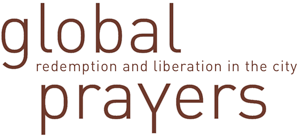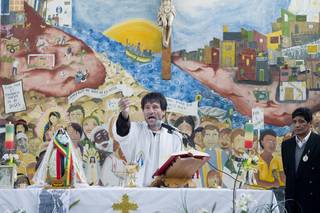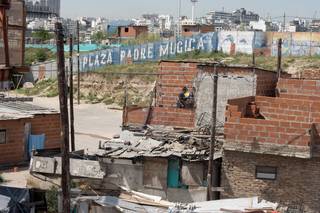Experiences from Mexico City and Buenos Aires
Since the late 1960s, mainstream Catholicism in Latin America has been strongly challenged by a new interpretation of the Bible as a manual for social transformation and political liberation. Seminaries all over the continent turned into political think tanks, some of the committed Christians started to support or joined armed resistance movements, and many of the social movements and urban struggles of the time would not have been possible without the rise of leftist, Marxist-inspired Catholicism. Today, the Catholic Church has clearly lost its monopoly in Latin America, and the "liberation spirit" has suffered from the general decline of Marxist agendas worldwide. Therefore, the religious field in Latin American megacities like Mexico City or Buenos Aires is characterized by a growing competition with other Bible-based beliefs and by the emergence of new public icons, such as the Santa Muerte in Mexico City or the Gouchito Gil in Buenos Aires.
This religious competition and the legacy of liberation theology as a former key reference for urban popular movements is the starting point for the case study we are conducting in Mexico City and Buenos Aires. Additionally, we are focusing on new expressions of urban popular religiosity (religiosidad popular) that we consider significant in the context both of Catholic culture and of the syncretic popular culture that can be found in a mestizo megacity such as Mexico City, but also in a 'Europeanized' city like Buenos Aires.
A first look at the outcome of the field research, realized simultaneously in both cities (September - December 2010) by a local research team and the project coordinator, confirms the initial assumption that liberation theology – conceived not as a theory but as a reflection of social, political and cultural praxis – is not to be seen as finished history but as memory that still produces meaning. In some sections of the cities - in the villas de emergencia, the poor areas of Buenos Aires, for example, or in some of the colonias populares in Mexico City - it is still active as a social practice that connects faith and urban poverty even now. In contrast to evangelical and Pentecostal messages, which are increasingly present in both cities, liberation theology is not about an inner, individual battle against 'evil spirits', but a collective battle, situated in social space, against the logics of exploitation and oppression. At the same time, classical liberation theologians were prone to dismiss all kinds of spiritual iconography (saints, virgins, miracles) as expressions of 'cultural alienation' and manipulation, and to overlook people’s emotional needs. This cultural 'arrogance' is considered one of the reasons for its loss of attraction and credibility.
The study pursues a series of questions that bracket history and the present: In what ways did liberation-oriented priests and churches participate in the urban struggles of the seventies and eighties, e.g. the plans of the Argentine junta to eradicate the villas, or dwellers claiming there right to urban services in the informal settlements in Mexico City? What was - or is - the role of the ecclesial base communities, a key element of the text-based methodology of liberation theology? How did (and does) this materialistic version of Catholicism relate to traditional Catholic popular culture as well as to new expressions of popular religiosity? How did (and does) this rather rational worldview relate to the individual need for a production of spiritual meaning and 'holiness'? Where do we find liberation theology as urban (cultural, social, political) practice today, and how does it relate to current urban conflicts like urbanization politics or drug-related crime? How do liberation-inspired agents perceive the new Christian churches - as spiritual enemies or as allies? Do they consider them as enemies that have to be defeated or as competitors that can be learned from? And who is to be considered the inheritor of liberation theology: the team of young village priests (curas villeros) in Buenos Aires who defend the villa culture and are supported by the conservative Cardenal, the group of veteran priests who promote a renewed option for the poor the Jesuits who have been preaching in Mexican colonias populares for more than four decades, the famous Marxist theologian who predicts a second wave of liberation poised to conquer the religious world?
The case study – realized in collaboration with local researchers Clarisa Fonseca Azuara (Mexico City) and Micaela Cuesta (Buenos Aires) – involves a set of approx. 25 interviews (video-recorded, transcribed) with some of the key actors of libertarian Catholicism in both cities and from different generations (priests and nuns, intellectuals, activists, writers) and ethnographic observations as well as archive material providing the urban and cultural context. In order to capture and visualize the place-making power of liberation theology, we have been focusing on a selection of significant urban parishes – located in villas, colonias or barrios – in both cities.
One of the core elements of the project is the visual research, realized by local photographers Verónica Mastrosimone (Buenos Aires) and Frida Hartz (Mexico City). Mastrosimone is an Argentine visual artist and documentary filmmaker who is particularly interested in social movements. Hartz is a senior press photographer who has been specializing in social and political reportage for more than 25 years, with a particular focus on Mexico City. Both photographers were invited to join the research team for the field research and to then go on and develop their own visual narrative based on one or several of the project’s topic areas. The goal of this design is to produce visual knowledge, to visibilize – more than just visualize – some of the underlying 'invisible' topics and tensions, such as faith and territory, despair and devotion, community and coexistence.
One example of the specific outcome is the visual essay by Frida Hartz on the new urban icon Santa Muerte that has emerged as a public cult on the streets of the inner-city quarter Tepito and spread all over Mexico City. The dressed-up skeleton, which is worshipped by an increasing number of the city’s poor and marginalized, is demonized by official Catholicism as well as by liberation priests. The photographic sequence allows a deeper insight into this 'strange ritual' that actually looks rather 'satanic' at first sight, but seems to have more to do with a desire for acceptance and a production of spiritual meaning. Hartz’s photographs tell us about devotion and pride, overlapping and coexisting 'religiosities', and the need to share and exhibit faith in public spaces.




